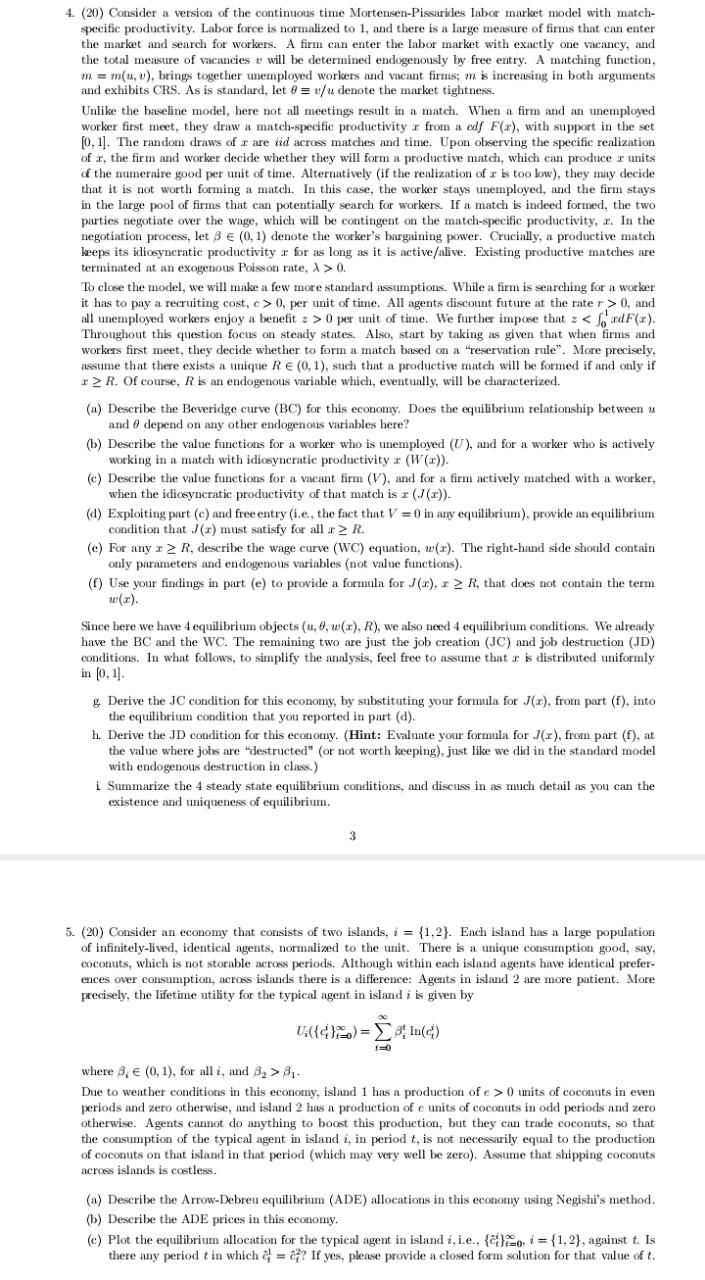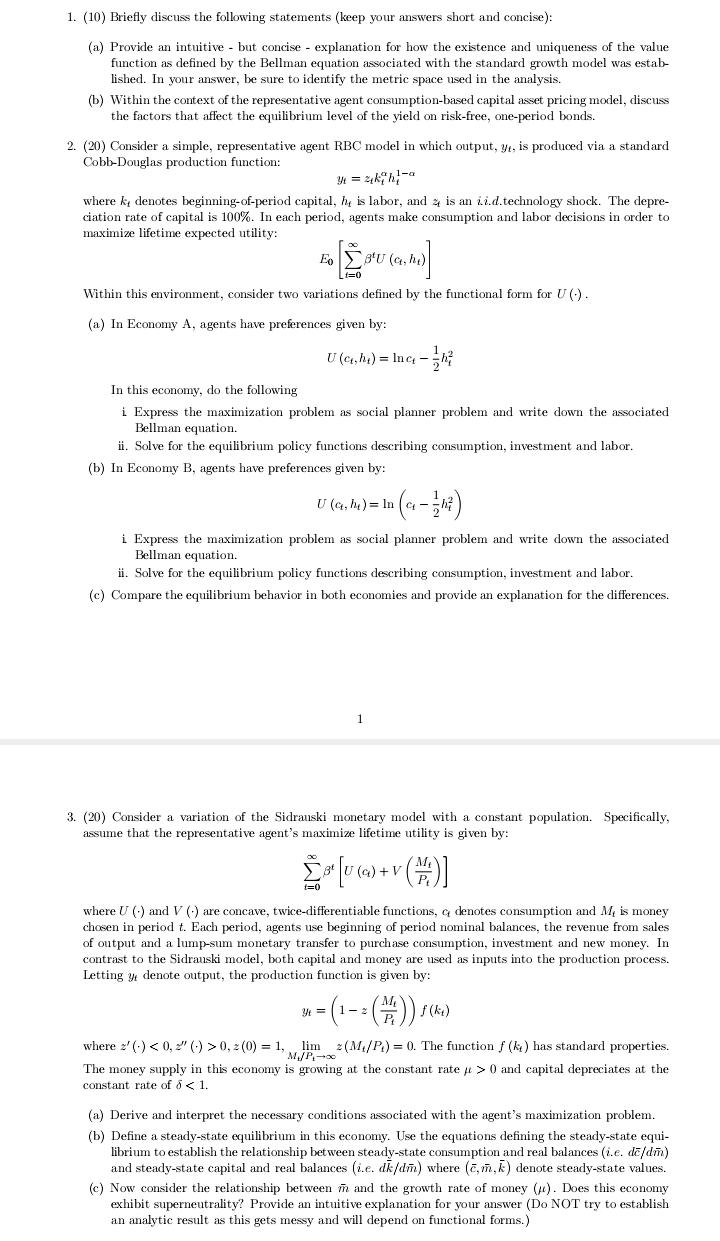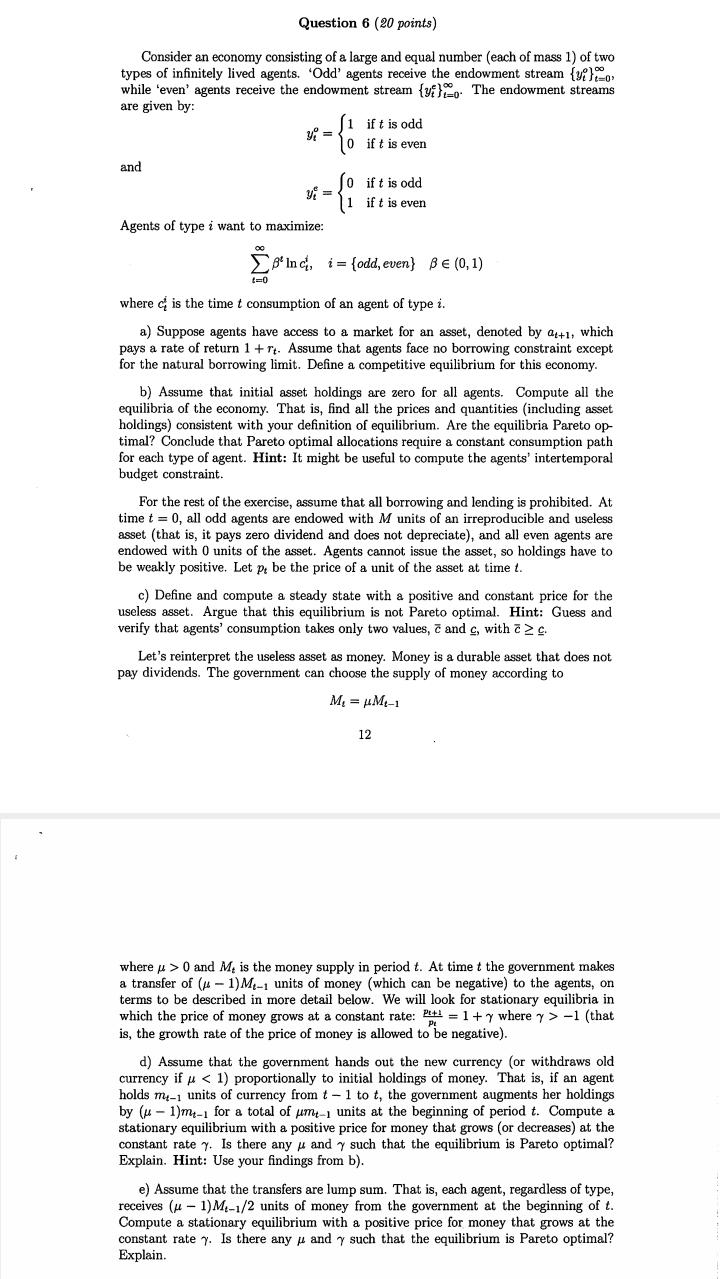



% Provide the solutions.
4. (20) Consider a version of the continuous time Mortensen-Pissarides labor market model with match- specific productivity. Labor force is normalized to 1, and there is a large measure of firms that can enter the market and search for workers. A firm can enter the labor market with exactly one vacancy, and the total measure of vacancies u will be determined endogenously by free entry. A matching function, m = m(u, v), brings together unemployed workers and vacant firms; m is increasing in both arguments and exhibits CRS. As is standard, let # = v/u denote the market tightness. Unlike the baseline model, here not all meetings result in a match. When a firm and an unemployed worker first meet, they draw a match-specific productivity r from a cdf F(x), with support in the set (0, 1). The random draws of r are rid across matches and time. Upon observing the specific realization of r, the firm and worker decide whether they will form a productive match, which can produce a units of the numeraire good per unit of time. Alternatively (if the realization of a is too low), they may decide that it is not worth forming a match. In this case, the worker stays unemployed, and the firm stays in the large pool of firms that can potentially search for workers. If a match is indeed formed, the two parties negotiate over the wage, which will be contingent on the match-specific productivity, r. In the negotiation process, let B e (0, 1) denote the worker's bargaining power. Crucially, a productive match keeps its idiosyncratic productivity r for as long as it is active/alive. Existing productive matches are terminated at an exogenous Poisson rate, > > 0. To close the model, we will make a few more standard assumptions. While a firm is searching for a worker it has to pay a recruiting cost, c > 0, per unit of time. All agents discount future at the rate r > 0, and all unemployed workers enjoy a benefit = > 0 per unit of time. We further impose that a 31- Due to weather conditions in this economy, island 1 has a production of e > 0 units of coconuts in even periods and zero otherwise, and island 2 has a production of e units of coconuts in odd periods and zero otherwise. Agents cannot do anything to boost this production, but they can trade coconuts, so that the consumption of the typical agent in island i, in period , is not necessarily equal to the production of coconuts on that island in that period (which may very well be zero). Assume that shipping coconuts across islands is costless. (a) Describe the Arrow-Debreu equilibrium (ADE) allocations in this economy using Negishi's method. (b) Describe the ADE prices in this economy. (c) Plot the equilibrium allocation for the typical agent in island i, i.e., (C)20, i = {1, 2), against t. Is there any period t in which & = 27? If yes, please provide a closed form solution for that value of t.1. (10) Briefly discuss the following statements (keep your answers short and concise): (a) Provide an intuitive - but concise - explanation for how the existence and uniqueness of the value function as defined by the Bellman equation associated with the standard growth model was estab ished. In your answer, be sure to identify the metric space used in the analysis. (b) Within the context of the representative agent consumption-based capital asset pricing model, discuss the factors that affect the equilibrium level of the yield on risk-free, one-period bonds. 2. (20) Consider a simple, representative agent RBC model in which output, y, is produced via a standard Cobb-Douglas production function: y = akih, -a where ky denotes beginning-of-period capital, he is labor, and & is an Li.d.technology shock. The depre- ciation rate of capital is 100%. In each period, agents make consumption and labor decisions in order to maximize lifetime expected utility: Within this environment, consider two variations defined by the functional form for U (.) . (a) In Economy A, agents have preferences given by: U (cq,h,) = Inc - -h; In this economy, do the following i Express the maximization problem as social planner problem and write down the associated Bellman equation. ii. Solve for the equilibrium policy functions describing consumption, investment and labor. (b) In Economy B, agents have preferences given by: U (G, he) = In (c - -17) i Express the maximization problem as social planner problem and write down the associated Bellman equation. ii. Solve for the equilibrium policy functions describing consumption, investment and labor. (c) Compare the equilibrium behavior in both economies and provide an explanation for the differences. 3. (20) Consider a variation of the Sidrauski monetary model with a constant population. Specifically, assume that the representative agent's maximize lifetime utility is given by: [ gu (a)+ V (#) ] where U () and V () are concave, twice-differentiable functions, q denotes consumption and M, is money chosen in period t. Each period, agents use beginning of period nominal balances, the revenue from sales of output and a lump-sum monetary transfer to purchase consumption, investment and new money. In contrast to the Sidrauski model, both capital and money are used as inputs into the production process. Letting y denote output, the production function is given by: 3 = (1 - = (7) 1(ki) where ='(.) 0, = (0) =1, lim =(M./P,) = 0. The function f (k ) has standard properties. The money supply in this economy is growing at the constant rate at > 0 and capital depreciates at the constant rate of 8 0 and M, is the money supply in period t. At time t the government makes a transfer of (# - 1)M- units of money (which can be negative) to the agents, on terms to be described in more detail below. We will look for stationary equilibria in which the price of money grows at a constant rate: " = 1 + y where y > -1 (that is, the growth rate of the price of money is allowed to be negative). d) Assume that the government hands out the new currency (or withdraws old currency if u 1 in period two. For example, an individual that invests an amount / will receive RI in period two, and has 1 - I stuffed under the mattress. In t = 1, individuals have the option of liquidating the long-term project at a penalty. If they liquidate, they only receive a return L - 1 (per unit invested) in period 1, rather than the return R in period 2. At time t = 1, a fraction * = 1/2 of the individuals receive a liquidity shock. These individuals are "impatient" and only value consumption in period one. The fraction 1 - " individuals that do not receive a liquidity shock are "patient" and only value consumption in period two. At time t = 0, all individuals have the same chance of being hit by the liquidity shock. Assume that individuals do not discount the future, so that their ex-ante expected utility is given by U = Tu(CI) + (1 - #)u(c2). where c and c, are the consumption in period 1 and 2, respectively, and u(c) = 1, with o > 0. a) Assume there are no financial markets available, so that individuals must simply invest on their own. Given that an individual has invested an amount / at time t = 0, what will be the optimal levels of consumption, C1, C2, if: (i) the individual receives a liquidity shock (i.e. is impatient); (ii) the individual does not receive a liquidity shock (i.c. is patient). Let c and & denote the consumption of an impatient individual in period 1 and of a patient individual in period 2, respectively. b) What is the optimal level of investment when individuals have to invest on their own? Denote this level by /. Hint: Show that there exists L, LE [0, 1] such that if L 2 L, the optimal level of investment is equal to 1, and if L - L, the optimal level of investment is zero. c) Suppose that when types are realized in period 1, this information is publicly observable. Suppose there exists a social planner that individuals entrust all of their endowment to at time 0. The social planner will pay impatient individuals cj in period 1 and patient individuals c; in period 2 (and zero otherwise). Solving the social planner's 9 problem, what is cf and c;? How much does the social planner invest? That is, what is I*? d) Assume that L = 1. Show that I* oz. In other words, show that the planner invests less than the individuals but it makes them face more consumption risk. e) Assume that L = 1 and o > 0. Now suppose an agent's type is private infor- mation, and the social planner can only offer a contract contingent on an individual's announcement of her type at time 1. Furthermore, at time 1, she meets each agent only once, with the meeting order randomly determined. If individuals report honestly, can the social planner achieve the same allocation as in question c)? Is it optimal for an individual to report honestly when everyone else does? f) Suppose that L = 1 and o w are claiming to the planner that they are impatient. Is it optimal for these agents to lie as well? Given your answer to this question, are runs possible when o














